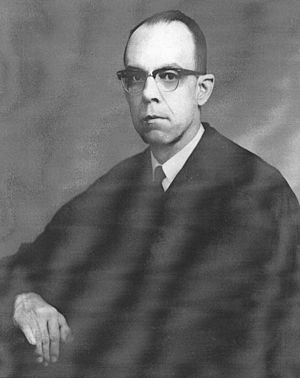Spottswood William Robinson III facts for kids
Quick facts for kids
Spottswood Robinson
|
|
|---|---|
 |
|
| Senior Judge of the United States Court of Appeals for the District of Columbia Circuit | |
| In office September 1, 1989 – October 11, 1998 |
|
| Chief Judge of the United States Court of Appeals for the District of Columbia Circuit | |
| In office 1981–1986 |
|
| Preceded by | Carl E. McGowan |
| Succeeded by | Patricia Wald |
| Judge of the United States Court of Appeals for the District of Columbia Circuit | |
| In office November 3, 1966 – September 1, 1989 |
|
| Appointed by | Lyndon B. Johnson |
| Preceded by | George Thomas Washington |
| Succeeded by | A. Raymond Randolph |
| Judge of the United States District Court for the District of Columbia | |
| In office January 6, 1964 – November 8, 1966 |
|
| Appointed by | Lyndon B. Johnson |
| Preceded by | James Ward Morris |
| Succeeded by | Gerhard Gesell |
| Personal details | |
| Born |
Spottswood William Robinson III
July 26, 1916 Richmond, Virginia, U.S. |
| Died | October 11, 1998 (aged 82) Richmond, Virginia, U.S. |
| Education | Virginia Union University (BA) Howard University (LLB) |
Spottswood William Robinson III (born July 26, 1916 – died October 11, 1998) was an important American. He was a teacher, a civil rights attorney, and a judge. He served on two important courts: the United States Court of Appeals for the District of Columbia Circuit and the United States District Court for the District of Columbia.
Contents
Becoming a Lawyer and Educator
Spottswood Robinson was born in Richmond, Virginia. His father was also a lawyer. Spottswood went to Virginia Union University. He then studied law at Howard University School of Law. He graduated in 1939, at the very top of his class. He had the best grades in the law school's history.
After law school, Robinson taught at Howard University School of Law. He taught there from 1939 to 1948. He also worked as a private lawyer in Richmond. This was from 1943 to 1960.
Fighting for Civil Rights
Robinson was a key figure in the civil rights movement. He worked for the NAACP Legal Defense and Educational Fund. This group helped fight for equal rights for African Americans. He was a lawyer for the Virginia NAACP from 1948 to 1950. Then he became a regional lawyer for the NAACP. This was from 1951 to 1960.
He later became a Professor and Dean at Howard University School of Law. This was from 1960 to 1963. He also served on the United States Commission on Civil Rights. This group worked to protect civil rights for all Americans.
Important Court Cases
In the early 1950s, Robinson worked on many civil rights cases. He often worked with his law partner, Oliver Hill. They helped African-American students in Virginia. These students were at a segregated school. It was called R.R. Moton High School in Farmville, Virginia. The students walked out because their school was in bad condition.
This led to a lawsuit called Davis v. County School Board of Prince Edward County. This case was combined with four other cases. Together, they became the famous Brown v. Board of Education case. The Supreme Court of the United States decided this case in 1954. This ruling said that separate schools for different races were not fair. Robinson was the first lawyer to speak for the students in this important case.
Robinson also worked on Chance v. Lambeth. This case made it illegal for travel companies to separate people by race. This applied to travel between states.
Serving as a Federal Judge
President Lyndon B. Johnson chose Spottswood Robinson to be a judge. On January 6, 1964, he became a judge. He served on the United States District Court for the District of Columbia. He was the first African-American judge on this court. He served there until November 1966.
Then, President Johnson chose him again for a higher court. On November 3, 1966, he became a judge. He served on the United States Court of Appeals for the District of Columbia Circuit. He was the first African-American judge on this court too. From 1981 to 1986, he was the Chief Judge of this court. He was the first African-American to hold this top position.
Robinson continued to serve as a judge. He took on a "senior status" role in 1989. This meant he worked a lighter schedule. He served until his death on October 11, 1998. He passed away in Richmond, Virginia.
A Key Legal Decision
Judge Robinson wrote an important legal opinion. It was for a case called Canterbury v. Spence. This decision said that doctors must get "informed consent" from patients. This means doctors must tell patients about their treatment. They must explain the risks and benefits. Patients need to understand and agree before treatment. This ruling changed how doctors and patients interact.


